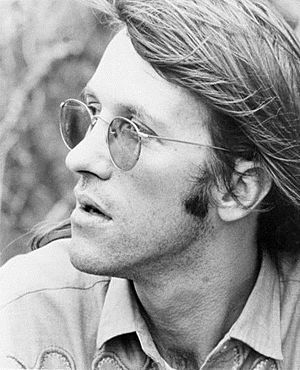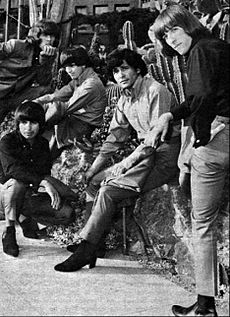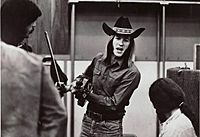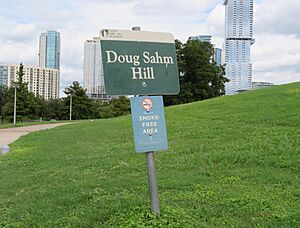Doug Sahm facts for kids
Quick facts for kids
Doug Sahm
|
|
|---|---|

Sahm in 1974
|
|
| Background information | |
| Birth name | Douglas Wayne Sahm |
| Also known as | Little Doug Doug Saldaña Samm Dogg Wayne Douglas |
| Born | November 6, 1941 San Antonio, Texas, U.S. |
| Died | November 18, 1999 (aged 58) Taos, New Mexico, U.S. |
| Genres | Tejano/Tex-Mex, Country, Rock, Blues, Rhythm and blues |
| Occupation(s) | Musician singer-songwriter bandleader |
| Instruments | Guitar, steel guitar, fiddle, mandolin, bajo sexto, dobro, drums, piano |
| Years active | 1946–1999 |
| Labels |
(Various)
|
| Associated acts |
(Various)
|
Doug Sahm (born November 6, 1941 – died November 18, 1999) was an American musician, singer, and songwriter. He was born in San Antonio, Texas. Doug Sahm is known as a key figure in Tex-Mex music and an important artist in Texan Music.
He became famous with his band, the Sir Douglas Quintet. Their song "She's About a Mover" (1965) was a big hit in both the United States and the United Kingdom. Sahm's music was shaped by the sounds of San Antonio, including conjunto and blues. Later, he was also influenced by the hippie music scene in San Francisco. His unique mix of music helped him find success in Austin, Texas, especially as the hippie culture grew in the 1970s.
Doug Sahm started singing at age five and learned to play the steel guitar at age six. People thought he was a child prodigy because he was so good at a young age. By age eight, he had already performed on the Louisiana Hayride radio show. He made his first recordings in 1955 as "Little Doug." As a teenager, he was inspired by rock and roll. He had local hit songs and played in clubs with other bands. In 1965, producer Huey P. Meaux helped Sahm and the Sir Douglas Quintet record "She's About a Mover." Sahm moved to California that same year. He returned to San Antonio in 1971, then moved to Austin. Atlantic Records signed him, and his first solo album, Doug Sahm and Band, came out in 1973.
Even when his record sales slowed down, Sahm kept performing in Austin clubs. He also found success in Sweden and Canada. In 1989, he formed a supergroup called the Texas Tornados. He joined forces with other Tex-Mex musicians like Augie Meyers, Freddy Fender, and Flaco Jiménez. The Texas Tornados had successful tours, and one of their albums even won a Grammy Award. Doug Sahm passed away in 1999 during a vacation. An album released after his death, The Return of Wayne Douglas, came out in 2000. Sahm received many honors in Texas, including being inducted into music halls of fame and having memorials in public places.
Contents
Early Life and Music Beginnings
Doug Sahm was born in San Antonio, Texas, on November 6, 1941. His family had moved to the United States from Germany in the early 1900s. They first settled in Galveston, Texas. Doug's grandparents owned a farm near Cibolo, Texas. His grandfather, Alfred Sahm, was a musician who played in a polka band. During the Great Depression, Doug's parents moved to San Antonio.
Doug started singing when he was five years old. He began playing the steel guitar at age six. That same year, he performed on San Antonio's radio station KMAC. He played the song "Teardrops in My Heart." People thought he was a child prodigy on the steel guitar. His mother took him to a music school, but his teacher soon said he couldn't teach Doug. The teacher explained that Doug could already play by ear and didn't need to learn to read music.
Doug often played at a local club called The Barn. His uncle co-owned this club with Charlie Walker. By the time he was eight, Doug could play the fiddle and mandolin. He started appearing on the Louisiana Hayride radio show as "Little Doug." He also performed with famous musicians like Hank Williams, Faron Young, and Hank Thompson. When he was thirteen, he was offered a chance to play on the Grand Ole Opry. However, his mother said no because she wanted him to finish school.
In 1953, Sahm met Augie Meyers while buying baseball cards. They became friends and talked about starting a band. But they both ended up playing with different groups for a while. Meyers became skilled at playing the accordion, piano, and rhythm guitar. Doug grew up in a mostly Black neighborhood on the East side of San Antonio. He listened to live performances by T-Bone Walker and other blues artists from a nearby blues bar. His neighbor, Homer Callahan, introduced him to music by artists like Howlin' Wolf and Fats Domino.
In 1955, a producer named Charlie Fitch released Doug's first song. It was called "A Real American Joe" and was credited to "Little Doug." That same year, Doug formed his first band, The Kings. A year later, one of his school concerts was stopped by the principal. Doug had started imitating Elvis Presley's dance moves. The students then went to Doug's house to keep listening to the band.
As he continued playing country music, a fiddler named J. R. Chatwell helped him. Doug was influenced by many artists during his teenage years. These included Lefty Frizzell, Howlin' Wolf, Elvis Presley, Little Richard, and T-Bone Walker.
Doug found success playing in San Antonio nightclubs. He played a mix of rhythm and blues with a saxophone player named Eracleo "Rocky" Morales. This "West Side Sound" of San Antonio was a blend of country music, conjunto, rhythm and blues, polka, and rock and roll. Doug also played guitar six nights a week with Jimmy Johnson's band.
Doug led three bands: The Pharaohs, The Dell-Kings, and The Markays. He released the song "Crazy Daisy" in 1959. He had a local hit with "Why Why Why" in 1960. Doug graduated from high school that same year. He had another local hit with "Crazy, Crazy Feeling" in 1961. Other songs like "Just A Moment" (1961) and "Lucky Me" (1963) followed. By 1964, Doug was no longer with the Renner record label. He tried to get producer Huey P. Meaux to sign him, but Meaux said no at first.
The Sir Douglas Quintet
Huey P. Meaux had produced many hit songs in the 1960s. But then, with Beatlemania and the British Invasion, his records stopped selling as well. Meaux wanted to understand why The Beatles were so popular. He bought their records and studied their sound. He felt the Beatles' songs had something in common with traditional two-step Cajun music. He called Doug Sahm and asked him to write songs in that style.
Doug put together a band with Augie Meyers (keyboard), Frank Morin (saxophone), Harvey Kagan (bass), and Johnny Perez (drums). Doug wrote a song inspired by The Beatles' "She's a Woman." He mixed their style with sounds from tejano music. Doug called his new song "She's A Body Mover." Meaux bought the song from him. He changed the title to "She's About a Mover" because he thought the original title wouldn't get played on the radio.
The song was released in 1965. It was credited to the Sir Douglas Quintet. Meaux created this "English-sounding" name to take advantage of the popular British Invasion. The first photos of the band were taken in shadow. This was to hide the appearances of Frank Morin and Johnny Perez, who were Latino members of the band. "She's About a Mover" became a big hit. It reached number 13 on the Billboard Hot 100 chart in the US. It also reached number 15 on the UK Singles Chart.
The success of the song led the Sir Douglas Quintet to tour. They opened for famous bands like The Beatles and The Beach Boys. They appeared on the TV show Hullabaloo. On the show, host Trini Lopez revealed where the band was really from. The quintet toured the United States with James Brown. They also toured Europe with The Beach Boys and the Rolling Stones.
After meeting Doug Sahm in New York City in 1965, Bob Dylan said he thought the Sir Douglas Quintet would be very popular on the radio. Dylan and Sahm met again in London when the Sir Douglas Quintet was touring England.
Moving to California and Back to Texas
Doug Sahm moved to Salinas, California. He became part of the growing hippie scene in San Francisco. He reunited with the musicians from the Sir Douglas Quintet, except for Augie Meyers. Meyers' parole officer wouldn't let him leave Texas. Doug got to know the music acts playing in the Haight-Ashbury area. He performed at famous places like The Fillmore and the Avalon Ballroom.
Through sound engineer Dan Healy, Doug met and became friends with Jerry Garcia. The Sir Douglas Quintet opened for the Grateful Dead in Oakland, California. In October 1966, they played with Big Brother and the Holding Company, which featured Janis Joplin. Doug was signed to Mercury Records and its smaller labels. In December 1968, Doug and his son, Shawn, were on the cover of Rolling Stone magazine. The magazine wrote about his arrival in San Francisco with other Texan musicians. In 1969, Augie Meyers joined Doug in San Francisco to record the album Mendocino. The album's main song reached number 27 on the Billboard Hot 100 chart.
Doug Sahm left California in 1971 and went back to San Antonio. He released an album called The Return of Doug Saldaña with the Sir Douglas Quintet. Chicano musicians in San Antonio had given him the nickname "Saldaña." An album cover of "Wasted Days and Wasted Nights" helped restart the career of its original singer, Freddy Fender. That same year, Rolling Stone featured Doug on its cover again and published an interview with him.
Doug moved to Austin in 1971 as the local hippie music scene grew. He played at places like the Armadillo World Headquarters. In 1972, he ended the Sir Douglas Quintet. That same year, he had a small role in the movie Cisco Pike, which starred Kris Kristofferson.
Jerry Wexler signed Doug Sahm to Atlantic Records in 1972. In October 1972, he recorded Doug Sahm and Band in New York City. Famous musicians like Bob Dylan, Dr. John, and Flaco Jimenez played on the album. The album received mixed reviews and didn't sell very well. In February 1973, he joined Willie Nelson during the recording of Shotgun Willie and played on that album. Doug also joined the Grateful Dead's recording sessions.
Doug continued to be popular in Austin's music venues. He used songs from his 1972 sessions for his 1973 album Texas Tornado. Atlantic Records closed its country music division in 1973. The next year, Warner Records released his album, Groover's Paradise. This album featured Doug Clifford and Stu Cook from Creedence Clearwater Revival. Texas Monthly magazine said the album captured the "carefree hippie mecca" feeling of Austin. While touring to promote the album, Doug performed for the first time at Carnegie Hall.
Doug Sahm's record sales continued to slow down. He rarely performed outside the Austin club scene. In 1976, he worked with Huey P. Meaux again on the album Texas Rock For Country Rollers. Doug sang and played lead guitar, fiddle, and piano. Augie Meyers also played piano and organ on the project. That same year, Doug appeared on the TV show Austin City Limits. In 1979, he had a small role in the movie More American Graffiti.
The 1980s, Texas Tornados, and 1990s
Doug Sahm released two albums on Takoma Records. The first was a solo album, Hell of a Spell (1980). The second was a collaboration with the Sir Douglas Quintet called Border Wave (1981). Doug reformed the band because new wave music was becoming popular.
Doug and the Sir Douglas Quintet signed a record deal with the Swedish label Sonet Records in 1983. Their album Midnight Sun was a big success. It sold 50,000 copies in Sweden and another 50,000 in other parts of Scandinavia. Its single "Meet Me in Stockholm" became a hit. Midnight Sun and their next album, Rio Medina, were recorded in the United States. Doug and the Sir Douglas Quintet toured Scandinavia and also played in the Netherlands.
By 1985, Doug Sahm had moved to Canada after visiting friends in Vancouver. But he returned to Austin every year for the South by Southwest festival. In 1987, he formed a band called The Texas Mavericks in Austin. Doug sang under the name "Samm Dogg." He and the band performed wearing wrestling masks. In Canada, he recorded The Return of the Formerly Brothers with Amos Garrett and Gene Taylor. This album won a Juno Award in 1989. In September 1989, Doug released Juke Box Music on Antone's Record Label. By the end of the 1980s, Doug often performed at the Austin night club Antone's.
In 1989, Doug Sahm formed the Texas Tornados. He joined with Augie Meyers (organ, vocals), Freddy Fender (guitar, vocals), and Flaco Jimenez (accordion, vocals). The group's songs had the Tex-Mex sound. This was a mix of rock, country music, conjunto, and blues. Warner Brothers signed the band. In 1991, they released Texas Tornados. The album reached number five on Billboard's Top Country Albums chart. It also won a Grammy Award for Best Mexican/Mexican-American Album. A Spanish version of the album, Los Texas Tornados, was released at the same time. The band performed in Europe and Japan. The Texas Tornados also played at the first inauguration of Bill Clinton with Willie Nelson.
In 1994, Doug Sahm and Augie Meyers formed a new version of the Sir Douglas Quintet. It included Doug's sons, Shawn on guitar and Shandon on drums. The band released the album Day Dreaming at Midnight. Doug then formed The Last Real Texas Blues Band. In 1995, this group recorded a studio album of their live performances. It was released as The Last Real Texas Blues Band Featuring Doug Sahm. The album included classic songs by T-Bone Walker. It was nominated for a Grammy Award for Best Traditional Blues Album.
The Texas Tornados' song "A Little Bit is Better Than Nada" was in the 1996 movie Tin Cup. In 1998, Doug Sahm worked with The Gourds on the album S.D.Q. 98'. That same year, he joined the Latino supergroup Los Super Seven. By 1999, Doug was impressed by singer Ed Burleson. He put together a band to record Burleson's first album, My Perfect World. This album was the first release on Doug's own label, Tornado Records. Doug used the same band to record his own songs in July and August 1999.
Personal Life
Doug Sahm met Violet Morris at a Christmas party in 1961. They got married in 1963. Violet had three children from a previous marriage. In 1964, she gave birth to their daughter, Dawn Sahm. Their first son, Shawn, was born in 1965, and Shandon in 1969. Doug and Violet divorced in 1973.
Doug Sahm loved baseball. He followed many teams and visited their training camps. He sometimes refused to go to music rehearsals so he could watch games. Once, he even turned down a tour to watch the World Series.
Death
In late 1999, Doug Sahm decided to take a vacation to New Mexico. He planned to visit a friend in Taos, New Mexico. Then he would go to a cabin in the mountains and finally visit Dan Healy in San Francisco. Doug left for New Mexico after a short visit with his son Shawn. During the trip, Doug called his son to say he felt sick. He often had to pull over to vomit.
Doug checked into a hotel in Taos, New Mexico. His son kept calling him over the next few days. Doug's girlfriend and Shawn offered to fly to New Mexico and drive him back to Texas. Doug first said no, but then agreed to drive himself to Albuquerque, New Mexico, to meet his girlfriend there. As he felt worse, he asked a hotel clerk about doctors who would visit him. He was told to go to the local emergency room, but he did not go.
On November 18, 1999, Doug Sahm was found dead in his hotel room. Local officials said he died of natural causes. An autopsy was done, and it showed that Doug died from a heart attack. The Austin Music Network aired a three-hour tribute to Doug. A memorial concert was planned for December 1999.
On November 23, 1999, Doug Sahm's funeral was held in San Antonio. About a thousand people came to pay their respects. Speakers were placed outside the funeral home so everyone could hear the service. People of all ages and backgrounds attended. Mourners passed by Doug's casket and left small gifts. Famous people like Bob Dylan, Bruce Springsteen, and Willie Nelson sent their condolences to the family. Doug Sahm was buried in a private ceremony in San Antonio, next to his parents.
In July 2000, the songs Doug recorded in 1999 were released. This posthumous (after death) album was called The Return of Wayne Douglas.
Legacy and Influence
Doug Sahm was known for his long hair, sideburns, sunglasses, and western clothes like cowboy hats and boots. His music style was a mix of country music, blues, rock and roll, Cajun music, rhythm and blues, and tejano music. He was also influenced by psychedelic music and jazz. People described Doug as "impulsive, restless, and energetic." He spoke very quickly and used hippie jargon. Doug was a multi-instrumentalist. He was skilled at playing the steel guitar, mandolin, fiddle, electric guitar, electric bass, dobro, bajo sexto, drums, and piano.
Rolling Stone magazine wrote that "Lone Star music, at its best, in every form, was religion to Sahm." The magazine ranked him at number 60 on their list of the 100 Greatest Country Artists of All Time in 2017. To Billboard magazine, Doug Sahm was a "central figure in the world of Tex-Mex." New Musical Express called him "an unpaid PR man for the state of Texas." The New York Times saw Sahm as "a patriarch of Texas rock and country music." Lone Star Music Magazine called him "the Godfather of San Antonio rock 'n' roll." The Austin Chronicle said: "If Texas had such designation, Douglas Wayne Sahm would be the State Musician of Texas." AllMusic described him as "a highly knowledgeable and superbly competent performer of Texan musical styles."
Doug Sahm was featured in the 1974 mural "Austintatious" in Austin. He was inducted into the Austin Music Awards Hall of Fame in 1982–1983. In 2002, the Americana Music Association gave him the President's Award. On October 13, 2002, San Antonio's mayor declared the date "Doug Sahm Day" in the city. In 2008, Doug Sahm was one of the first people inducted into the Austin Music Memorial. On April 10, 2008, the Austin City Council approved renaming a spiral hill in Butler Metro Park to Doug Sahm Hill. This was to honor his "great talents in the music industry." The 35-foot (11 m) hill is the highest point in the park. It offers a 360° view of Austin's skyline.
In November 2009, artist David Blancas finished a mural called La Música de San Anto. It is on the west side of San Antonio and features San Antonio musicians, including Doug Sahm. Another artist, Federico Archuleta, also painted two murals of Doug Sahm in Austin.
In 2009, a tribute album called Keep Your Soul: A Tribute to Doug Sahm was released. It featured San Antonio musicians. On Doug's birthday, November 6, 2010, a plaque was added to the top of Doug Sahm Hill. The plaque has a drawing of Doug by Kerry Awn and a short biography. Also in 2010, Shawn Sahm and the Texas Tornados released the album ¡Está bueno!. Doug's son and the remaining members of the group toured to promote the album. In 2015, Doug Sahm was inducted into the South Texas Music Walk of Fame. That same year, music writer Joe Nick Patoski showed his documentary about Doug Sahm, Sir Doug and the Genuine Texas Cosmic Groove, at the South by Southwest festival. Patoski started a petition to get Doug Sahm inducted into the Rock and Roll Hall of Fame. The film was re-released in 2022. A special showing in San Antonio included a Q&A session with original Sir Douglas Quintet members Augie Meyers and Jack Barber. Music producer Kevin Kosub created a small museum with items from Doug Sahm's career.





